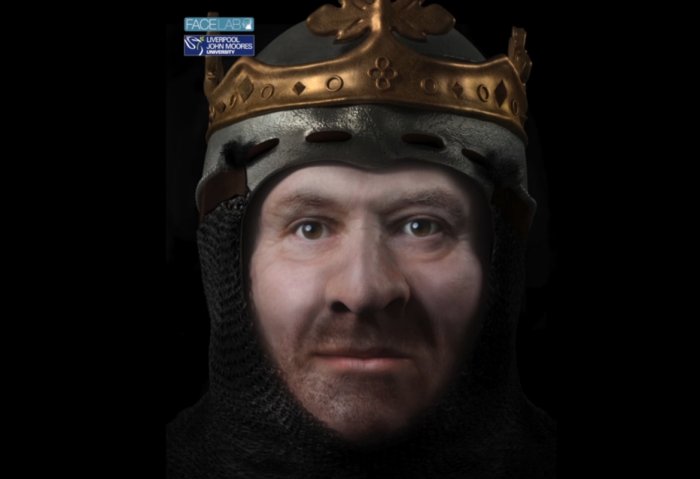MessageToEagle.com – Robert the Bruce is a Scottish hero who is today remembered for fighting one of the most significant battles in English and Scottish history.
Robert I, popularly known as Robert the Bruce was born on July 11, 1274. He reigned as the King of Scots until his death in 1329.
Robert the Bruce family were not native Scots. His mother’s family was of Scots Gaelic descent and his father, who had come over to England with the army of William the Conqueror had in roots in Normandy. William the Conqueror rewarded Robert the Bruce’s father by granting him lands in Yorkshire, but the family had added to this inheritance by acquiring considerable lands in Huntingdonshire and in Annandale, Scotland.
Historians and scientists have long wondered what Robert the Bruce looked like in real life.
No reliable visual depictions of Robert the Bruce were made in his own time, and written records tell us nothing about his appearance.
Now, researchers from the University of Glasgow and Liverpool John Moores University (LJMU) have created detailed virtual images of what could be the head of Robert the Bruce, reconstructed from the cast of a human skull held by the Hunterian Museum.
The study was led by Dr Martin MacGregor, a senior lecturer in Scottish history at the University of Glasgow. Dr MacGregor was inspired by the discovery of the skeleton of King Richard III of England beneath a car park in Leicester in 2012.
“I was aware of previous attempts to recreate the face of the skull linked to Robert the Bruce,” he said.
“The case of Richard III revealed how far the technology had advanced. I saw an opportunity to apply the technology to the Hunterian skull held here at Glasgow: first to test the credibility of its connection to Bruce, and then to try to add to our knowledge of Scotland’s greatest king.”
Together with Professor Caroline Wilkinson, Director of LJMU’s Face Lab and a world-renowned craniofacial identification expert, Dr MacGregor and the other scientists were able to carry out the facial reconstruction of Robert the Bruce.
See also:
Robert The Bruce: Mighty King Of Scots And Great Scottish Hero
Face Of 2,000-Year-Old Meritamun: Ancient Female Egyptian Mummy Reconstructed
Facial Reconstruction Of Ava: 3,700-Year-Old Bronze Age Woman
Facial Reconstruction Of ‘Mrs Getty’ – A High-Status Young Anglo-Saxon Woman
Is This The Face Of A 16th Century Pirate Or Criminal?
One image depicts the subject in his prime, a large and powerful male head that would have been supported by a muscular neck and stocky frame – a match for the super-athletes of today. This was a privileged individual who enjoyed the benefits of a first-class diet, and whose physique would have equipped him for the brutal demands of medieval warfare.
However, the second image reveals that strength co-existed with frailty. The skull exhibits likely signs of leprosy, disfiguring the upper jaw and nose.
Historians believe Bruce suffered from an unidentified ailment, possibly leprosy, which laid him low several times during his reign, and probably killed him. In Ulster in 1327, he was said to be so weak that he could only move his tongue.
DNA would offer another way to establish Robert the Bruce’s hair and eye colour – but there is a problem.
Robert the Bruce was buried in the choir of Dunfermline Abbey and his grave marked by an impressive gilded white marble tomb imported from Paris. The tomb was lost in the turmoil of the Reformation era, but a grave and fragments of carved and gilded stone, believed to be those of the vanished tomb, were found in 1818 and later given to The Hunterian and to the National Museums of Scotland. A further fragment has recently been found in the collections at Abbotsford, the home of Sir Walter Scott.
“The skull was excavated in 1818-19 from a grave in Dunfermline Abbey, mausoleum of Scotland’s medieval monarchs,” explains Dr MacGregor. “After the excavation the original skeleton and skull were sealed in pitch and reburied, but not before a cast of the head was taken. Several copies of the cast exist, including the one now in The Hunterian, but without the original bone we have no DNA.”
“The Hunterian also holds a piece of toe-bone said to have come from the same grave, and not returned to it. We had hoped to try and obtain DNA from this and test it against a living descendant of Robert the Bruce, but the bone would probably have been destroyed in the process.”
Professor Wilkinson added: “In the absence of any DNA, we relied on statistical evaluation of the probability of certain hair and eye colours, conducted by Dr MacGregor and his team, to determine that Robert the Bruce most likely had brown hair and light brown eyes.”
MessageToEagle.com








